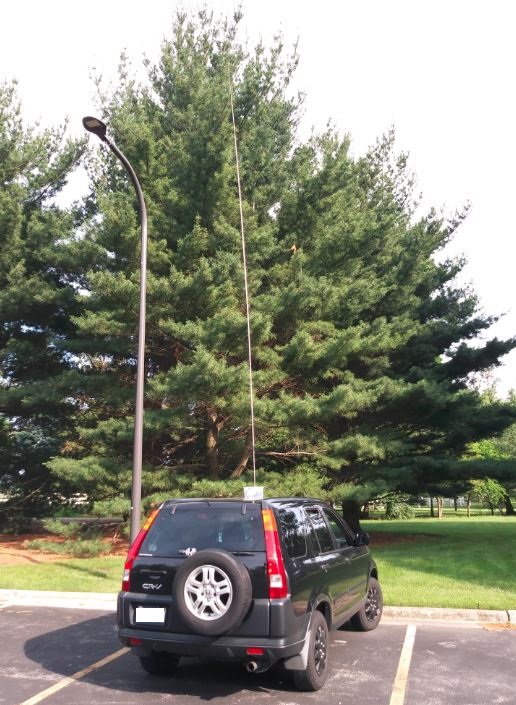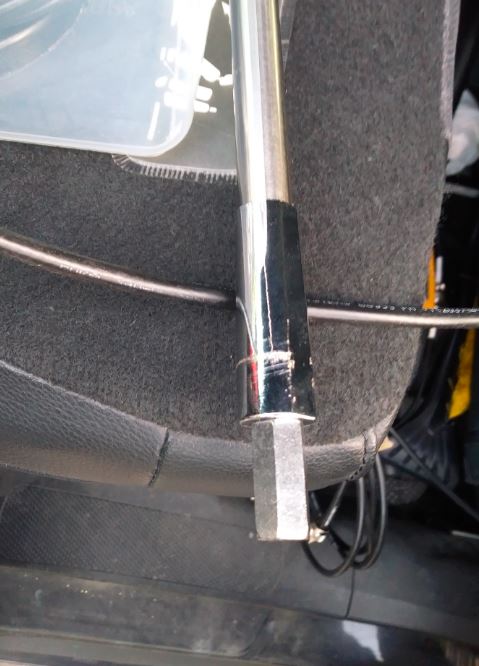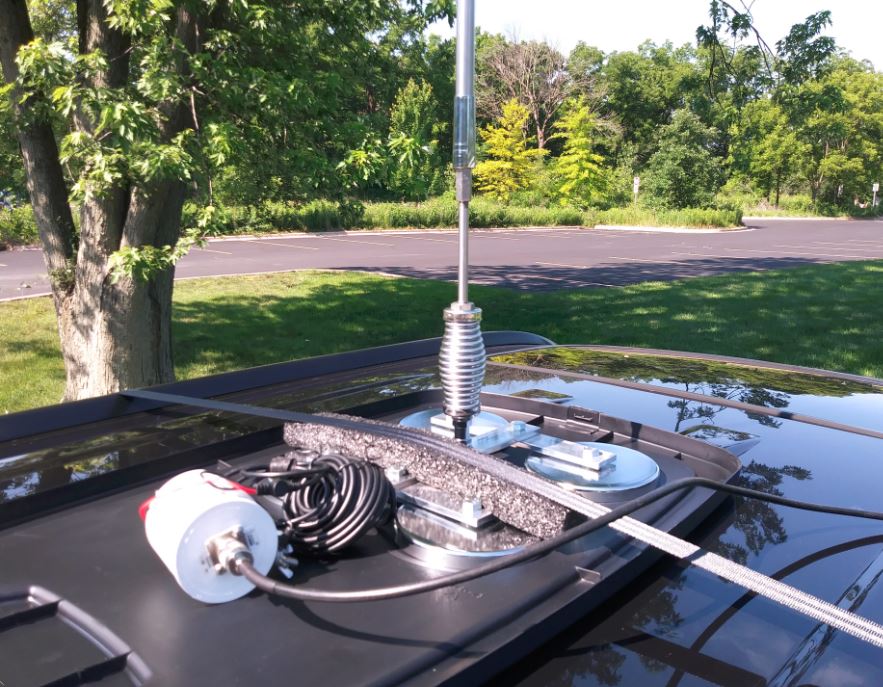Many thanks to SWLing Post contributor, TomL, who shares the following guest post as a his Backpack Shack 3 continues to evolve:
Backpack Shack 3.0 – Part 3
I have now gone overboard since I think bigger must be better. The temptation was just too great and now there is an MFJ-1979 17-foot telescoping whip antenna in my car (with consequences).
MFJ Angst
I have a love/hate relationship with MFJ products because of what I think are useful ideas that are made somewhat poorly. But I went ahead and bought the large whip since I figured they could not possibly screw up something so simple, right?
Wrong. As I excitedly tried to screw the supposed 3/8”-24 threaded end into the nice standard Firestik K-11 magnet mount, I realized I was turning and turning it but it was not going in!!! I even had a small steel sliver of metal sticking into my flesh to prove I was not dreaming. The previous day, it had screwed in very tightly, but it did screw in. So, there I was after a long day of work, ready to listen to some SWL-Nirvana and I could not get the blasted antenna into the mount–? That Firestik mount is a VERY standard 3/8”-24 female thread and the other third-party antenna shafts fit perfectly and easily EVERY time I use them. I hate $60 of poor workmanship and MFJ seems to be the poster child of overpromising and underdelivering.
I was determined to make this work, by force if needed. One of the Trucker antenna shafts by necessity had an extra coupling nut on it to allow the extra 18 inch shaft to connect, so I took it off there and tried to thread it onto the MFJ-1979. It barely moved. Not to be thwarted, I dug out an adjustable wrench and 3/8” socket wrench with ½” socket and grunted and twisted and tightened until the coupling nut was threaded all the way “up its shaft”. That is what I feel like telling MFJ! That coupling nut is never coming off and now that I truly have bought it and cannot return it, I might as well use it.
The stainless steel telescoping rod is extremely thin and feels like it can bend and dent with any kind of mishandling. So it resides collapsed in a 27 inch PVC pipe with plumbing pipe foam inside to baby it when it is not being used. It remains to be seen if I can remember to “Handle With Care” when extending/collapsing it. We’ll see.
Ready-to-go
OK, so using the 18 inch antenna shaft attached to the magnet mount, then the coupling nut on the MFJ antenna, I extended it to a total of about 13 feet. With the DX Engineering Pre-amp turned on, and using the SDR Play RSP2, I was getting many signals booming in. All the usual names we are familiar with – RMI, CRI, Turkey, Cuba, etc. But also the noise level was very high. I know it is summer but I may have been overloading the Pre-amp a little bit. Here is an example, Radio Progresso from Cuba with some very nice acapella music but also a noisy background (plus, a noisy laptop computer pulse!):
Click here to download MP3 audio.
So I decided to come back in the morning before my workday started and see if the static crashes would have died down.
Preamp Angst
The next morning I had everything hooked up again in the same spot at the Forest Preserve (located in a suburb of Northern Illinois). I moved the Cross Country Preselector to be directly connected from the roof, then to the antenna switch on the “Breadboard” (see part 2) to better prevent overloading. I turned on the Verizon battery pack and nothing. No Pre-amp light. Switched it on, off, on, off – nothing. So, I thought I must have burnt it out the previous session?
Later on, I found it was some sort of short in the switch and I will have to move the D-cell batteries to a backup battery pack. In the meantime, I had to do without the Pre-amp and was forced to extend the MFJ antenna all the way. With the 18 inch extension attached to the magnet mount, that was a total of 18.5 feet from antenna tip to the top of my car roof.
This was actually fortuitous since I was already concerned about overloading the Pre-amp or perhaps amplifying background noise. This forced me to test it in a more “barefoot” manner, hearing what it would natively hear without any Pre-amp. It was also lucky there was no wind to blow it over! It seems that if one is in an RFI-quiet area with decent view of horizons, the 20+dB Pre-amp may not be needed, depending on frequency band involved.
I have read that “Norton” style 10 dB Pre-amps and custom handmade transformer baluns are used by Dr. Dallas Lankford in his Low Noise Vertical antennas. I don’t want to get into winding baluns so I am using one Palomar Longwire Balun to simulate the “magnetic” transfer. His design uses two, one 10:1 at the antenna and a 1:1 balun at the feedline into the house. For more reading on LNV antennas, see these references:
- http://www.ve1zac.com/Lankford Antenna References .htm
- ve7sl.blogspot.com/2015/01/the-low-noise-vertical.html
- Lankford – The Best Small Antennas For MW, LW, And SW rev 2
UNAMPed Results
I purposely monitored Voice of Korea for their news statement on the De-Nuke talks on the 25 meter band and found it came in great, just as many others have heard it. This was encouraging. Examining carefully the Data file from the SDR, here is what I pulled from it. I am pleasantly surprised and happy with the results; some stations I had never heard before and the language and music are very exotic. All of it was a little more than one half hour of recording time (14 June 2018, 1300 UTC). You may have to crank up the volume on the weaker recordings to hear those properly.
Recordings
(Station, Frequency, Language(s), Transmitter site from www.short-wave.info):
Voice of Vietnam, 12020 kHz, English, Hanoi Vietnam (with local UFO noises near me)
Click here to download MP3 audio.
HCJB Beyond Australia-India, 11750 kHz, Nepali, Kununurra OZ
Click here to download MP3 audio.
Veritas, 11850 kHz, Vietnamese, Quezon City Philippines
Click here to download MP3 audio.
VOA, 11695 kHz, Cambodian, Tinang Philippines
Click here to download MP3 audio.
KCBS, 11680 kHz, Korean, Kanggye North Korea
Click here to download MP3 audio.
CRI, 11650 kHz, Esperanto (they get PAID to speak Esperanto!), Beijing China
Click here to download MP3 audio.
Taiwan International, 11640 kHz, Chinese, Kouhu Taiwan (blasting in strongly plus strong echo of broadcast at top of the hour – is a second transmitter signal going around the earth the other way and getting to me??)
Click here to download MP3 audio.
FEBA India, 11580 kHz, Malayalam scheduled but announcer says “Kannada”, Trincomalee Sri Lanka
Click here to download MP3 audio.
Radio Free Asia, 11540 kHz, Tibetan, Tinian Island signoff and transition to Kuwait (very faint)
Click here to download MP3 audio.
BBC, 12065 kHz, English, Kranji Singapore (ETWN not on air to mask this)
Click here to download MP3 audio.
Japan NHK, 11740 kHz, Thai, Kranji Singapore
Click here to download MP3 audio.
CRI, 11910 kHz, Amoy signoff transition directly to English, Beijing China
Click here to download MP3 audio.
FEBC, 12095 kHz, Hmong signoff transition directly to Khmu, Bocaue Philippines
Click here to download MP3 audio.
Radio Free Asia, 12140 kHz, Cambodian signoff transition directly to Burmese, Saipan
Click here to download MP3 audio.
Extreme Loading
Eighteen feet of whippy rod can sway in the gentlest breeze (consequences of “bigger must be better”). The described setup has fallen over in as little as a 12 mph sustained wind when fully extended because I had the base in a plastic box. I want plastic under the magnet(s) in order to get it off easily and put away out of sight! Now installed is a larger QUAD magnet mount for better stability:
ProComm PCTM54 Quadruple Mag Mount
I am using the flat plastic lid from a 20 gallon tote container under the quad mount and a mover’s tie down strap to the main bar of the quad (I have room for multiple straps if needed). Ten foot fits just fine:
Erickson 34415 Black Retractable Ratchet Straps 2 Pack
A spring is attached to the base as well (strongest one I could find):
Hustler SSM-3 Super Heavy Duty Spring
Finally, the connecting stainless steel shaft at the base is a 5 inch Wilson 305-5 stainless steel shaft.
Because the backpack and quad mount can fit inside the 20 gallon tote container, this setup can be attached to a picnic table in a state park or campsite if I choose. The Firestik single magnet mount will be recycled as a VHF antenna mount. I can go virtually anywhere now.
Instead of the 20+dB DX Engineering Pre-amp, perhaps one of those “Norton” 10 dB Pre-amps might be optimal (Kiwaelectronics.com broadband-preamp). And I need to figure out why my Verizon battery pack failed as each Tenergy D cell measured fine. Oh yeah, I have to buy an extra coupling nut, too……
Happy Listening,
TomL
Thanks so much for sharing this latest iteration of the BackPack Shack 3.0, Tom! It seems to me, as you imply, your current setup could be installed pretty much anywhere.
I’m sorry to hear about your troubles with MFJ. I’ve only had good experiences with them in the past, but I suspect the specs on the 3/8”-24 thread were simply incorrect or perhaps metric and mislabeled.
Post readers: Read Tom’s past contributions and articles by clicking here.




Would be really interested to know how you use your Cross Country Wireless PreSelector.
Great set-up. Thanks for posting!
Best Wishes
At the moment, I am using it at the end of the chain of components just before the SDRPlay receiver. For some reason, it has a slightly sharper response compared to putting it in front of the MW filter and preamp. I find the SDRPlay RSP2 to overload easily unless I filter it with both the MW filter and the Preselector. I tend to like to push the SDR to the the next highest LNA setting in SDR Console ver.3.
I am not using the external preamp unless I take the backpack on a hike away from the car setup or if it is very windy and I am forced to shorten the telescoping antenna to half its length.
Hope that helps.
Yes, it does. Thank you for responding so quickly. I’ve just purchased one which I have yet to try out, but hope to be doing so soon.
Best Wishes,
David
I cannot understand why you guys think bigger is better: On shortwave even one meter of wire collects enough ambient noise that an amplifier with a high-impedance input provides ample output. Not to forget: The noise from that bit of wire is enough to completely drown the amplifier noise. Between such a big antenna and the RSP you need an attenuator, not an amplifier.
At least if you give that antenna a counterpoise so the antenna current has somewhere to go: From what you consider to be the antenna, through the cable to the receiver, back through the shield of the cable to the rest of the antenne (the counterpoise).
There is one thing you can do: give the antenna some directional characteristic. The easiest way is a magnetic antenna with a resonant circuit that has two minima. Turn that antenna around to maximize S/N ratio.
If you have enough space build a Beverage antenna that is hardly more as a length of wire you roll out in the direction to the transmitter.
On shortwave antenna efficiency is only important if you wish to transmit. Then your signal must be louder that the ambient noise.
Thanks for the sincere comments. I am not as proficient as some others regarding electrical characteristics of antennas but I still find them fascinating. It is my understanding that the trucker magnetic mount is providing a capacitive connection to the car body which is my counterpoise (assuming the manufacturer connected the shield of the coax properly to the mount and isolated that from the center conductor). This is what I read is how CB antennas work.
As far as bigger, 18 feet unamplified is somewhat short for optimal reception. Dr. Lankford seems to like multiple 45 foot vertical antennas that are phased to give him directionality. If someone could help me understand how to setup multiple 45 foot phased vertical magnetic transfer antennas on my CAR, I would be all ears to that possibility.
Unfortunately, NOISE has forced me from my home and I feel like a lonely Mad Max road warrior when trying to snatch weak signals out of the air. I also noticed that very few, if any, shortwave listeners have actually documented a viable mobile form of setup that is somewhat comfortable. I am inspired by the efforts of the MW Ultralight DXers who brave stormy Pacific coast wind and rain just to catch those amazing trans-Pacific broadcasts. For now, the CB trucker parts combined into a vertical with a magnetic balun is working for me. It is quite exciting to hear things I have never heard before!!
Re: capacitive connection to ground plane/counterpoise: I haven’t really thought much about it before, but my general opinion has always been in line with the common understanding that a mag mount probably provides adequate coupling at VHF & above, but not at HF.
I admit, though, that I hadn’t really examined, calculated, or tested that opinion. Some quick calculations – 4 x 5″ diameter magnets, calculate area, throw in some likely spacings & dielectric constants – and I come up with … hmmm, a few 10’s to a couple of 100 nF.
That’s actually higher than I thought, and not bad at all – that equates to < 1 to a few 10's of ohms at HF. Your assumption might actually be right, at least for that mount… 😉
That said, I do tend to agree with DL4NO about noise – that's the real issue; SNR is much more important than absolute signal level. And verticals tend to be noise magnets, particularly for electrical noise, than other possible options.
RE: Noise, supposedly that is the reason for the “magnetic balun” transfer. Near the listener’s house, it keeps noise from entering the radio from the pick up on the shield. Secondly, at the antenna, the balun transfers the signal magnetically, eliminating some of the man-made noise (not quite sure how, something to do with H-field vs. E-field sensitivity to man-made noise), thereby Increasing the signal/noise ratio. That is why RF Systems antennas were so popular in Europe where a lot of SWL hobbyists lived in cramped quarters with electrical wires and TV’s and such. Not an engineer, so who knows, it seems to work….
I have two of these stainless steel whips. They each fit the thread specs. And in every mount that I’ve put them in that take this standard 3/8-24 standard.